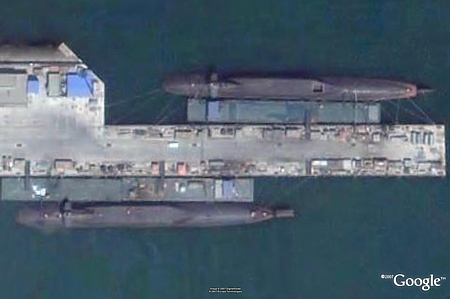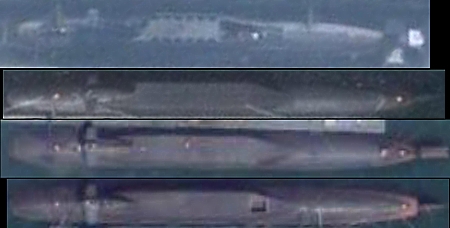 |
|
China appears to have launched two more SSBNs. |
By Hans M. Kristensen (BLOG UPDATED OCTOBER 10, 2007)
China appears to have launched two more ballistic missiles submarines from the Bohai shipyard at Huludao approximately 400 km east of Beijing. This could bring to three the number of Jin-class (Type 094) nuclear-powered ballistic missile submarines (SSBNs) launched by China in the past three to four years.
The two submarines were discovered during analysis of newly published commercial satellite images on Google Earth. This is the second time in three months that FAS has discovered new Chinese ballistic missile submarines on commercial satellite images. The first time was in July 2007, when the first Jin-class was disclosed on the FAS Strategic Security Blog.
The submarines on the new image have the same dimensions as the previous submarine.
So How Many Do They Have?
Whether China has now launched two or three Jin-class SSBNs is still unclear. The image of the first SSBN discovered at Xiaopingdao in July 2007 was taken on October 17, 2006. The new image of the two SSBNs at Huludao was taken six and a half months later on May 3, 2007. One possibility is that the Xiaopingdao SSBN returned to Huludao for repair or further adjustment and was captured on the 2007 photo together with the second SSBN. Another possibility is that the two Huludao SSBNs are indeed the second and third boats of the new Jin-class SSBN.
The U.S. Office of Naval Intelligence estimated in December 2006 that “a fleet of probably five TYPE 094 SSBNs will be built in order to provide more redundancy and capacity for a near-continuous at-sea SSBN presence.” China has not stated how many SSBNs it plans to build and there is no authoritative information available in the public that confirms that China plans to build five SSBNs. It might, but it might also build less if it decides that three or four are sufficient.
Some Implications
The new Jin-class SSBNs add to the single and unsuccessful Xia-class (Type 092) that China launched in 1982. The Xia has never conducted a deterrent patrol and its operational status is in doubt. The rapid launch of two or three Jin-class SSBNs indicate that the Chinese navy feels confident it has overcome at least some of the technical problems that curtailed the Xia.
|
|
 |
|
Comparison of Chinese SSBNs discovered on commercial satellite images made available on Google Earth since 2005 show clear differences between the Xia-class (Type-092) and the new Jin-class (Type 094). The roughly 23-meter missile compartment on the Xia (top) has been extended to about 34 meters on the Jin-class. The Jin-class photographed at Xiaopingdao (second from top) and the two at Huludao have the same dimensions, indicating that China has launched at least two boats. To download larger image, click on the image above or here. |
Each Jin-class appears to have 12 launch tubes for the new Julang-2 sea-launched ballistic missiles that are currently under development. If Julang-2 and three Jin-class SSBNs become fully operational, it would enable China to deploy up to 24 ballistic missiles at sea, assuming one boat would be in overhaul at any given time (and the Xia is still not operational). The range of the Julang-2 is estimated by the US intelligence community at more than 8,000 km (4,970+ miles), which brings Hawaii and Alaska (but not the continental United States) within reach from Chinese territorial waters.
Despite many rumors on the Internet about multiple warheads on Julang-2, the long-held assessment by the US intelligence community is that the Julang-2 will be a single-warhead missile.
Whether China plans to deploy a continuous sea-based deterrent is unknown. It appears doubtful because it would break with the Chinese practice of not deploying fully operational nuclear missiles. Nuclear warheads for China’s land-based missiles are believed to be stored separate from the missiles, although this has never actually been verified for the entire force. If the submarines deployed into the Pacific (like U.S. and to a smaller extent Russian SSBNs) it would also break with Chinese policy of not deploying nuclear weapons outside Chinese territory. An alternative would be to operate the SSBNs as a surge capability, intended to deploy in a crisis.
Background: Other Blogs About China
The FY2026 National Defense Authorization Act (NDAA) paints a picture of a Congress that is working to both protect and accelerate nuclear modernization programs while simultaneously lacking trust in the Pentagon and the Department of Energy to execute them.
While advanced Chinese language proficiency and cultural familiarity remain irreplaceable skills, they are neither necessary nor sufficient for successful open-source analysis on China’s nuclear forces.
Satellite imagery has long served as a tool for observing on-the-ground activity worldwide, and offers especially valuable insights into the operation, development, and physical features related to nuclear technology.
This report outlines a framework relying on “Cooperative Technical Means” for effective arms control verification based on remote sensing, avoiding on-site inspections but maintaining a level of transparency that allows for immediate detection of changes in nuclear posture or a significant build-up above agreed limits.